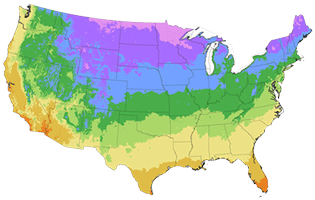Protecting Fruit Trees From Frost Damage
This is a common question in spring. Yes, freezing temperatures can damage the flowers on the tree and any potential fruit production from those blooms could be lost. How much your harvest will suffer depends on how low temps get and for how long. It also depends on the stage of development.
As buds swell and development begins, the ability to withstand cold temperature changes with the growth stage. Early swollen buds can often withstand temperatures in the teens (degrees Fahrenheit) without any damage. As buds develop and begin to open, temperatures in the low 20s can cause harm to fruit buds and perhaps developing leaves.
Unfortunately, spring freezes are almost a certainty in any given year. Fruit growers need to constantly assess the stage of development of their crops and the susceptibility to freeze injury.
Protection From Frost

For most fruit trees, open blossoms and the growth phase just after petal shed are the most sensitive to frost or freeze damage. In order to salvage your blooms, we suggest getting creative and covering the tree to protect blooms from the freezing, cold air.
Use a cloth or burlap to cover the tree and trap in warm air. Be sure to completely cover the tree and extend fully down to the ground to provide adequate protection. You also don't want your material sticking to blooms, this could cause even more damage. Stakes can be used for support.
Keep trees and plants covered only when temperatures are freezing. Remove them as soon as possible to allow pollinators back in and to keep your trees from getting too much heat when the day begins to warm.

For larger trees, the covering can be difficult. If you can't cover, then consider over-head watering for an ice glaze that will protect your tree. Overhead sprinklers protect plants by using the heat given up by water when it turns from a liquid to a solid to warm the plants. Running water creates an ice layer and by continuing to water, you get a slow melt. It's the rapid thawing that causes damage. As long as the water is applied continuously at an adequate rate and is freezing, plant temperature will remain consistent and above freezing.
Similar steps can be taken for small fruits and other garden plants.
Preventing Early Blooming
Consulting with your local extension and speaking with growers in your area will also inform you on what thrives best in your climate. Of course, weather patterns ultimately cue your tree to begin blossoming. Even the right fruit trees for your climate can bloom earlier than expected.
Your planting location could also be a factor in pre-mature blooming. When initially planting your new trees, avoid locations that are heat sinks (surroundings that create higher ambient air temps like fences, brick walls, dark ground cloth, and south-facing slopes) - especially for apricots and peaches. Location is a huge factor in the overall success of your fruit harvest.
- Article Categories:
- Winter Gardening









































